E.1027: What Happens in E.1027 Stays in E.1027
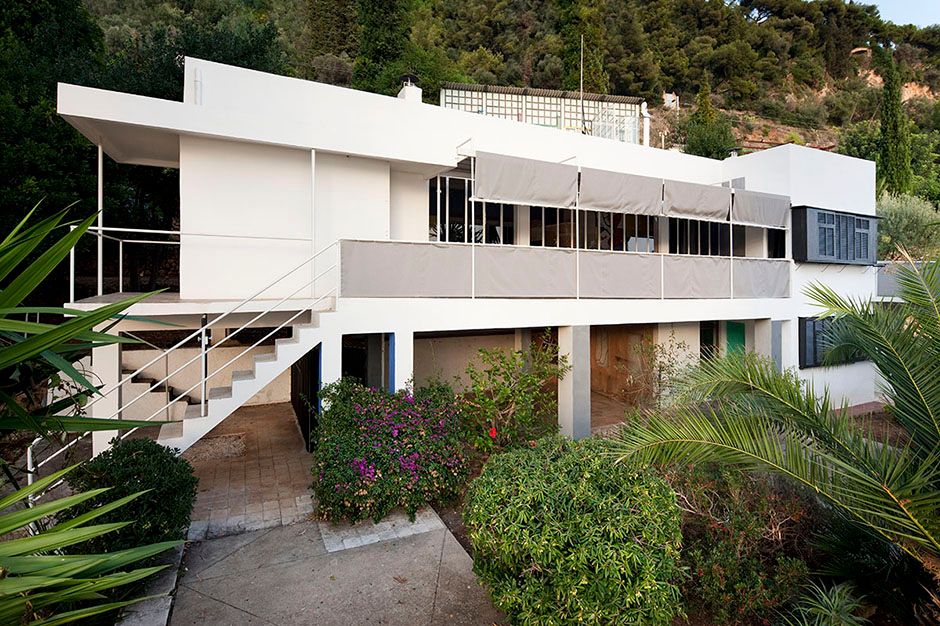
Introduction
E.1027 is small modernist house on the French Riviera that after many years of neglect has been restored and opened to the public. Two things make this building special, first it is a wonderful and early example of a modernist house and secondly its story illustrates the tension between integrity and reputation and what this can lead to.
The House
E.1027 was designed by Eileen Gray then already in her 50’s and built between 1926-1929 making it an early example of Modernism, that it was by a woman during those times makes it even more remarkable. Not only that but for those three years of building she was often on site overseeing construction.

E1027 From above (Photo © Manuel Bougot)
The house was for herself and her partner Jean Badovici and its name is a code of their names, Eileen Gray and Jean Badovici, ‘E’ standing for Eileen, ‘10’ Jean, ‘2’ Badovici, ‘7’ Gray.
Already this might give a hint that this modernist building might be a little different. The naming of the house as a code appears to be a computation, maybe a machine id number, a real modernist name. But in reality it was an intermingling of the names of the two people it was built for, Eileen’s name enclosing Jean’s.
The building sits under a cliff in Roquebrune-Cap-Martin near Monaco. It reflects the sensibilities of a woman who in many ways was modern ahead of her time.
Eileen Gray
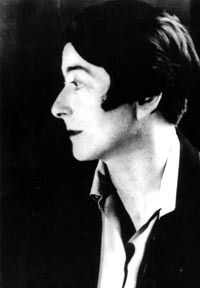
Eileen Gray
Born into an Aristocratic Irish family she went away to study in Paris and ended up running her own interior design studio in the 20’s and 30’s.
E.1027 was a vacation getaway, an intimate home away from the social scene in Paris but ready for entertaining smaller groups. Not only did Eileen Gray design the building but most of the furniture that would go inside, her Bibendum chair being a notable example. Everything was considered as a whole, everything cantered on the personal experience of the building.
“One must build for the human being, that he might rediscover in the architectural construction the joys of self-fulfillment in a whole that extends and completes him. Even the furnishings should lose their individuality by blending in with the architectural ensemble.”
- Eileen Gray as quoted in the Curbed Article
Gray was amply able to articulate a strong response to Paris’s high chief of architecture Le Corbusier and his machines for living;
We will be killed by hygiene!…No. They are intoxicated by the machine. But there is more than the machine. The world is full of living references, living symmetries….Their excessive intellectuality wants to suppress those things that are wonderful in life….Their desire for strict precision has made them neglect the beauty of all these forms; spheres, cylinders, undulating and zigzag lines, ellipsoidal lines that are like straight lines in move-ment. Their architecture has no soul.
(quoted in Constant, 1996, p. 70) -pg9 occupying E1027
Layout
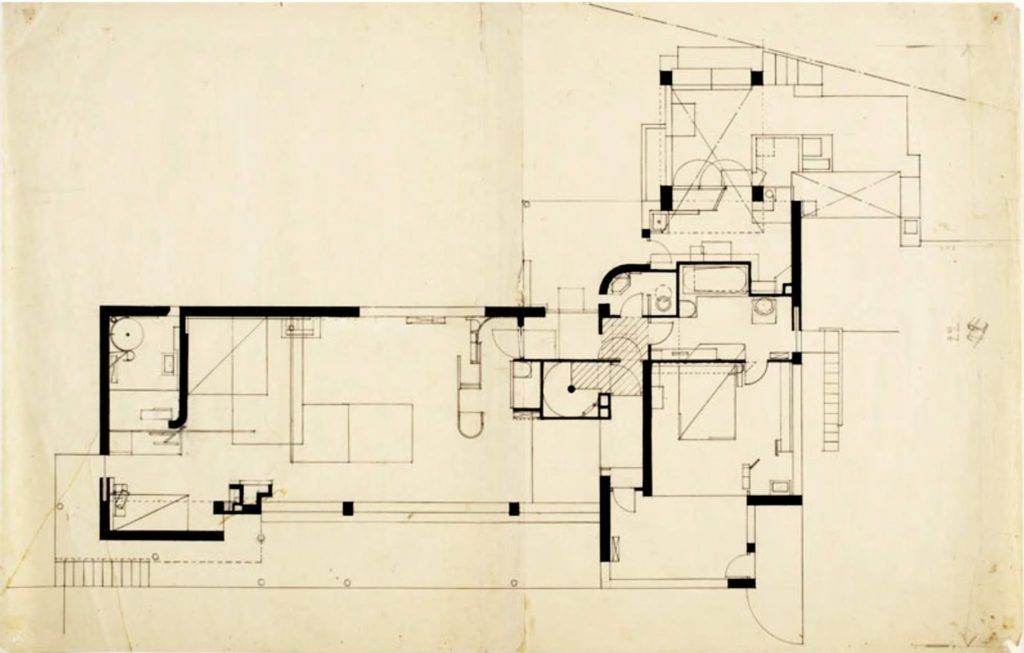
Plan of E.1027 shows Balcony overlooking sea at the Bottom.
The layout is just very well considered, main living and entertaining space with large balcony have the views out to the sea. The main bedroom space to the East catches the rising sun is very private with its own balcony. Service spaces are to the north facing the slope.
Notice the curves in the walls and furniture here and there. The transition spaces and routes have been considered and allowed to flow but it’s not for show just practical.
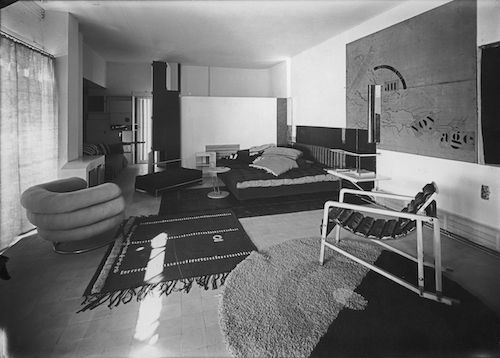
Living Room, before Le Corbusier (photo: Friends of e.1027)
This was a perfect bolt hole for the couple away from Paris. But E.1027 didn’t see much use by the couple it was designed for, soon they had broken up and Badovici was left to use it himself and invite his friends to stay with him in the summers. Gray designed and built a new home for herself not far away.
Le Corbusier
It was in 1930 when Badovici invited Corbusier and his long suffering wife first to E.1027, Gray and Badovici were already over as a couple, she didn’t go back to E.1027 after 1932. But throughout the 30’s almost every summer Corbusier came to stay there with his wife, Badovici letting them vacation there as they wanted as they were good friends.
In the spring of 1938 Le Corbusier even wrote to Gray to her to express his admiration of her work;
I would be delighted to relate how much those few days spent in your house have made me appreciate the rare spirit that dictates all of its organization, both inside and outside, and has given the modern furniture and equipment a form that is so dignified, so charming, and full of wit.
Then something happened, Corbusier started painting murals on the walls of E.1027. It was the summer of 1938 that le Corb started on the first of the mural just months after he had written to Gray. He even had someone take a photo of him doing it while naked, a photo he happily later distributed himself. The murals were garish and sexually explicit, it’s hard to dismiss the likelihood they were aimed at Gray.

Le Corbusier documenting his defacement of E.1027 in the Summer of 1938.
It was probably not until 1946 after the war that Gray became aware that Corbusier had defaced her building. In that year Corbusier published some photographs of his ‘murals at cap martin’ in _Oeurvre Complete _Gray’s name was not even mentioned.
The villa that I animated with my paintings was very beautiful, white on the interior, and it could have managed without my talents,”
he admitted, before claiming that the murals
burst out from dull, sad walls where nothing is happening . . . an immense transformation, a spiritual value introduced throughout.
There was no mention at all of the Author of the building by Corbusier. Gray wrote angrily to Badovici, Corbusier had altered her design, defaced it, he was just a guest what did he think he was doing? A friend quoted her as feeling like she had been raped.
Badovici wrote to Le Corbusier and accused him of vanity amongst other things;
What a narrow prison you have built for me over a number of years, and particularly this year through your vanity
Le Corb wrote back but directly to Gray
You want a statement from me based on my worldwide authority to show- if I correctly understand your innermost thoughts - to demonstrate ’ the quality of pure and functional architecture’ which is manifested by you in the house at Cap Martin, and has been destroyed by my pictoral interventions. OK, you send me some photographic documents of this manipulation as pure functionalism….Also send me some documents on Castellar, this u-boat of functionalism; then I will spread this debate in front of the whole world.
A not at all veiled threat from Corbusier who doesn’t even bother denying anything, just brushes the accusation off with a threat to her reputation.
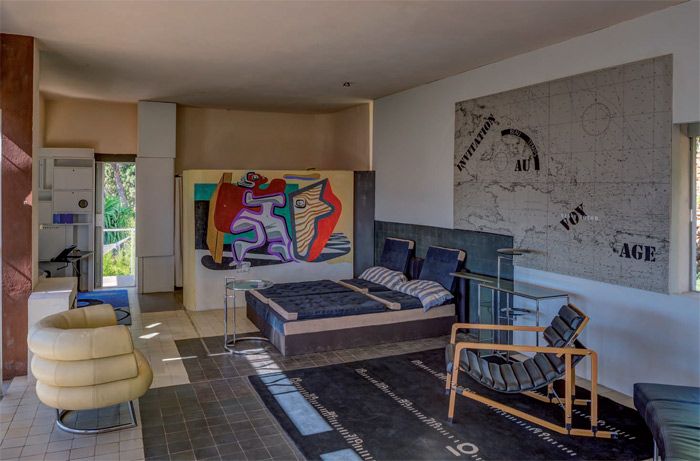
Living Room Restored with with one of Le Corbusiers murals.
Let’s be clear Corbusiers’ murals were acts of destruction by him, he even agreed. In a letter in 1932 to Vladimir Nekrassov he wrote
I admit the mural not to enhance the wall, but on the contrary as a means to violently destroying the wall, to remove from it all sense of stability, of weight etc…..Why then to paint on the walls….at the risk of killing architecture? It is when one is pursuing another task, that of telling stories
Corbusier went further. In 1950 he bought a small plot of land above E.1027. Infact he had ‘befriended’ Thomas Rebutato and persuaded him to have a restaurant above the site and to build a set of five apartments there designed for tourists. Le Corbusier was to have one as payment but he negotiated a small plot of land next to the restaurant instead where he built a shack.
The site for E.1027 chosen for its isolation and privacy from overlooking neighbours was now overhung by Le Corbusier’s buildings. But not just by his buildings but himself hanging around like a stalker, although no longer welcome in E.1027 he came every summer and literally physically was perched over the building sitting in his own shack.
After Badovici
In 1956 Badovici died, Eileen Gray had what would be her last chance to visit E.1027 but she couldn’t make it down the track to the building, she was too upset. The new owner Marie-Louise Schelbert, suspiciously another friend of Corbusier was carefully told by Corbusier that she had a masterpiece in her hands and not to throw anything away. Corbusier probably wanted it for himself but couldn’t afford it. In 1965 against the advice of his Doctor Le Corbusier went swimming in the Sea at Roquebrune-Cap-Martin in front of E-1027 and drowned.
After Marie-Louise Schelbert died in 1975 the ownership of the house went to her morphine addicted Doctor Peter Kaegli who didn’t look after the house much and was murdered there, the ownership of the house was now unclear and contested and the building left to slowly rot. Over most of the 80’s and 90’s it was locked up, in disrepair and slowly falling apart. In 1989
Le Corbusier’s “shack” has been lovingly kept as a small museum, looked after by the Commune of Roquebrune and visited by students and admirers of a glorious moment of modern architecture. A few yards away one of the purest examples of the same period [E.1027] is slowly dying.
In 2000, the French state and the municipality of Roquebrune-Cap-Martin bought the house and then declared it a monument historique. Then a non-profit organisation was formed to raise money and to restore the building, which itself was controversial.
The House is now restored open to the public, but unfortunately Corbusiers murals are also still there.
Corbusiers Superpower
It’s worth spending a little time really looking closely at what Le Corbusier did and what it meant. What happens when an Artist gains a reputation that outweighs others around so much they can impose themselves even on the others’ work? How might that power be used?

One of Le Corbusiers murals (Photo by jpmm)
Le Corbusier was the foremost avant-garde Architect in Paris, and one of only a few of international reputation at that time, and he was well aware of this fact. His murals were part destruction of Eileen Grays building and part usurping. Le Corbusier had imposed himself on E1027 forever from within with the murals and from without by cramping a masterpiece with a few of his own lesser works.
The murals are crude and sexual they don’t reflect the intent of the house on any level, and they were made like that on purpose. The naked painting of them part of the provocation.
He had by then been going to the house every summer for eight years and would go holidaying to that exact same rock face for tens of years after, clearly he had an inferiority complex about E.1027 and did what he could to insert himself into the buildings story.
Because of the close association of the site with Le Corbusier even the Villa itself was often misattributed to him. It was close to unthinkable especially when now published that someone could take the building back and remove the ‘art’ or graffiti that defaces the original work.
Like a dog pissing in the corner marking their territory, this building was now important, not because it was a great work of Architecture by Eileen Gray, but because he, Le Corbusier, had painted his artwork on the walls!
Le Corbusier’s strange relationships with women are of note here. His closeness to his mother, his lifetime marriage which he would frequently, nonchalantly abuse with numerous affairs. Perhaps Eileen Gray as a woman from the same Paris scene who seemingly effortlessly matched Corbusier and had little time for his bombastic sloganising exposed Corbs jealous weaknesses too much?
By fate almost it was in the sea below E.1027 that Le Corbusier would drown in the summer of 1965.
Back to E.1027
The Last word must go back to Eileen Gray and to the House though. There is now a friends of E.1027 group dedicated to its preservation. There have now been a handful of excellent articles about it. Eileen Gray and E.1027 have been rediscovered and it sits and welcomes us on its own terms once again.
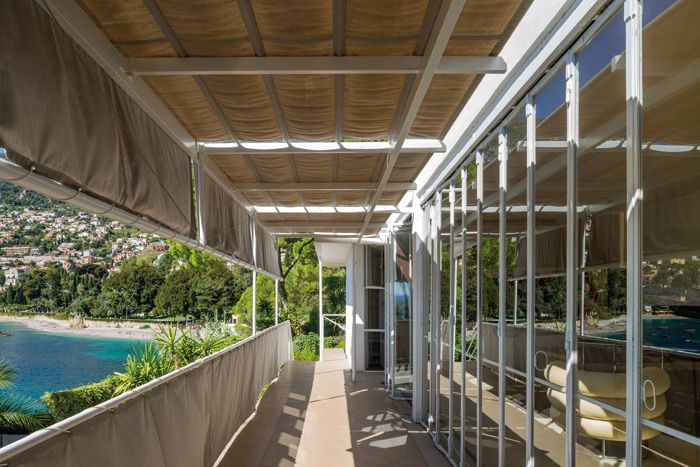
Awnings Protecting the balcony of E.1027
Further Reading
- Curbed: A House is a Machine For Memory
- Alistair Gordon: House of Usher
- Manuel Bougot - has an amazing sweet of photos to view on his website
- E.1027 in Hidden Architecture - Good Description of just the building
- Misfit Wrote about Eileen Gray and E.1027 with a good analysis of the design of E.1027.